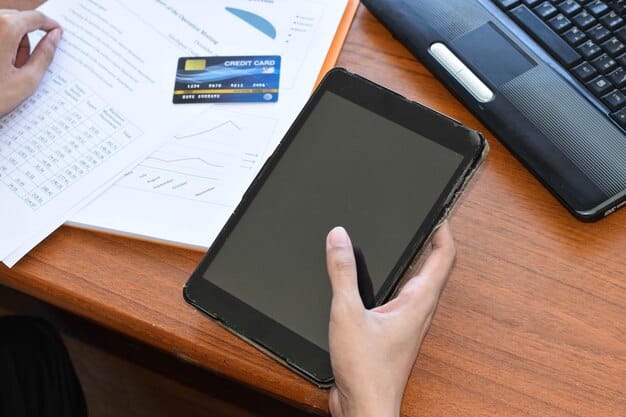Create Your Emergency Fund: Protect Against Unexpected Expenses

Creating a personal emergency fund is a crucial step to safeguard your financial stability, providing a financial cushion to navigate unexpected expenses like medical bills or job loss without derailing your long-term financial goals.
Life is unpredictable, and unexpected expenses can arise at any moment. That’s why knowing how to create a personal emergency fund is essential for protecting yourself from financial hardship and ensuring peace of mind. Having an emergency fund acts as a financial safety net, allowing you to handle unforeseen costs without resorting to debt or compromising your long-term financial goals.
Why You Need a Personal Emergency Fund
An emergency fund isn’t just a good idea; it’s a financial necessity. It provides a buffer against life’s inevitable surprises, preventing you from incurring debt or depleting your savings when unexpected events occur. It offers that crucial peace of mind, knowing you’re prepared for financial hurdles.
The unexpected can happen at any time
Life has a habit of throwing curveballs. A sudden job loss, a medical emergency, or an unexpected car repair can quickly derail your finances. Without an emergency fund, you might face difficult choices like racking up credit card debt or postponing essential expenses.
Avoid debt and financial stress
Relying on credit cards or loans during an emergency can lead to a cycle of debt that’s difficult to escape. An emergency fund allows you to cover unexpected costs without resorting to high-interest debt, reducing financial stress and preserving your credit score.
- Job Loss: An emergency fund bridges the gap while you seek new employment.
- Medical Expenses: Unexpected health issues can lead to substantial bills.
- Home/Auto Repairs: These can quickly drain your regular budget.
- Unexpected Travel: Emergency situations might require urgent travel.
An emergency fund is a crucial tool for managing financial surprises and maintaining long-term stability. It provides a safety net that allows you to tackle unforeseen challenges without jeopardizing your overall financial health.
How Much Should You Save in Your Emergency Fund?
Determining the right amount for your emergency fund is a personal decision, but a commonly recommended goal is to save three to six months’ worth of living expenses. This provides a financial cushion to cover essential costs during a period of job loss or other financial hardship. Let’s explore this in greater detail.

Estimate your monthly living expenses, including housing, utilities, food, transportation, and other essential costs. Then, multiply this figure by three and six to determine your target range for your emergency fund.
If you have a steady income and a low-risk job, three months’ worth of expenses might be sufficient. However, if you have a variable income, work in a volatile industry, or have significant debt, aiming for six months’ worth of expenses is a wise choice. An emergency fund of three to six months is a great goal to achieve.
- Assess Income Stability: Consider how stable your job or source of income is.
- Evaluate Monthly Expenses: Know precisely how much you spend on necessities.
- Consider Debt Levels: Higher debt might warrant a larger emergency fund.
- Account for Health: Consider your health risks and related potential costs.
The ideal size of your emergency fund depends on your individual circumstances, but saving three to six months’ worth of living expenses is a solid starting point. This financial cushion will provide peace of mind and protect you from unexpected financial setbacks. It’s like having a financial safety net, so make sure it covers your essential expenses.
Setting a Savings Goal and Creating a Budget
Establishing a clear savings goal and creating a budget are fundamental steps in building your personal emergency fund. With a defined target, you can stay motivated and track your progress, while a budget helps you identify areas where you can save money and allocate funds towards your goal. These are the first steps you will need to take.
Determine a realistic savings target
Decide how much you want to save in your emergency fund. As mentioned earlier, a common recommendation is three to six months’ worth of living expenses. Base your target on your personal circumstances, needs, and risk tolerance.
Track your monthly income and expenses
Use budgeting apps, spreadsheets, or traditional pen and paper to monitor your income and expenses. This will give you a clear picture of your spending habits and identify areas where you can cut back.
- Identify Non-Essential Expenses: Look for opportunities to reduce spending.
- Automate Savings: Set up automatic transfers from your checking to your savings.
- Track Your Progress: Regularly review your budget and savings progress.
- Make Adjustments: Refine your strategy as your financial circumstances change.
Setting a clear savings goal and creating a detailed budget are crucial for building a strong emergency fund. These steps will help you stay focused, track your progress, and make informed decisions about your finances, ensuring you reach your savings target. Achieving this goal will give you reassurance.
Where to Keep Your Emergency Fund
Choosing the right place to store your emergency fund is crucial. You want it to be easily accessible when needed but also safe and secure. High-yield savings accounts offer a good balance of accessibility and interest earnings. The accessibility is an important factor to consider.

Compare interest rates and fees at different banks and credit unions to find the best deal. High-yield savings accounts typically offer higher interest rates than traditional savings accounts, allowing your money to grow faster.
Make sure your savings account is FDIC-insured, which protects your deposits up to $250,000 per depositor, per insured bank. This ensures that your money is safe even if the bank fails. Your money will be safe with these insurance options.
- Online Savings Accounts: Often offer higher interest rates.
- Money Market Accounts: Provide competitive rates and limited check-writing abilities.
- Certificates of Deposit (CDs): Consider these for funds you won’t need immediately.
- Avoid Investing: Keep emergency funds in low-risk, liquid accounts.
The best place to keep your emergency fund is in a high-yield savings account that’s easily accessible and FDIC-insured as a safe approach. You want your funds to be secure and available when you need them most, providing you with financial security and peace of mind. You want the financial security needed for your emergency fund.
Replenishing Your Emergency Fund
Once you use your emergency fund, it’s essential to replenish it as soon as possible. This ensures that you’re prepared for future unexpected expenses, maintaining the safety net that you worked hard to build. Getting back on track is an important step.
After using your emergency fund, make replenishing it a top priority. Adjust your budget to allocate more funds towards savings until you reach your desired emergency fund level.
Explore additional ways to increase your income, such as taking on a part-time job, freelancing, or selling unwanted items. Channel any extra income towards your emergency fund. It can be done with careful planning and quick work.
- Cut Non-Essential Spending: Redirect funds to your emergency fund.
- Automate Replenishment: Set recurring deposits to rebuild your savings.
- Allocate Windfalls: Use bonuses, tax refunds, or gifts to boost your fund.
- Stay Disciplined: Resist using your savings for non-emergencies.
Replenishing your emergency fund after you use it is a vital step in maintaining your financial security. By prioritizing savings and finding ways to increase your income, you can quickly rebuild your safety net and remain prepared for any future financial challenges. This can be achieved in a reasonable timeframe.
Other Tips for a Strong Financial Foundation
Building a strong financial foundation involves more than just having an emergency fund. It also requires managing debt responsibly and planning for larger, less frequent expenses. Here are some additional tips to consider.
Prioritize paying off high-interest debt, such as credit card balances, to reduce your overall financial burden. Consider strategies like debt consolidation or balance transfers to lower your interest rates.
In addition to your emergency fund, create sinking funds for larger, less frequent expenses, such as car repairs, home maintenance, or vacations. This helps you avoid dipping into your emergency fund for predictable costs.
- Create an Emergency Budget: Prepare for potential reduced income or job loss.
- Set Realistic Goals: Ensure your financial targets are achievable.
- Review Insurance Coverage: Evaluate and update your policies for adequate protection.
- Get Professional Advice: Consult a financial advisor.
By responsibly managing debt and planning for larger expenses, you can further strengthen your financial foundation and protect yourself from unexpected financial setbacks. These strategies, combined with a well-funded emergency fund, will help you achieve long-term financial stability and peace of mind. Be certain to factor in debt and additional expenses.
| Key Point | Brief Description |
|---|---|
| 💰 Savings Goal | Aim for 3-6 months of living expenses in an accessible savings account. |
| 📝 Budgeting | Track income and expenses to identify savings opportunities. |
| 🏦 Where to Save | Use a high-yield savings account for emergency funds. |
| 💸 Replenishing | Prioritize rebuilding the fund after each use by adjusting the budget. |
Frequently Asked Questions (FAQ)
▼
The time it takes varies depending on your income, expenses, and savings rate. Start small, aim for consistency, and consider automating your savings to reach your goal faster.
▼
Ideally, emergency funds should be reserved for unexpected, essential expenses like medical bills, job loss, or home repairs. Try to avoid using it for discretionary spending.
▼
Start with a smaller goal, such as $500 or $1,000, and gradually increase it over time. The important thing is to start saving something, no matter how small.
▼
While easy access is important, keeping it all in cash doesn’t earn interest. Opt for a high-yield savings account to get the best of both worlds: liquidity and growth.
▼
Review it at least once a year or whenever your financial circumstances change significantly. Adjust your savings goal as needed to ensure it still meets your needs.
Conclusion
Creating a personal emergency fund is a crucial step toward financial security. Start by setting a savings goal, creating a budget, and choosing the right place to keep your money. By following these steps, you can build a financial safety net that protects you from unexpected expenses and provides peace of mind.





